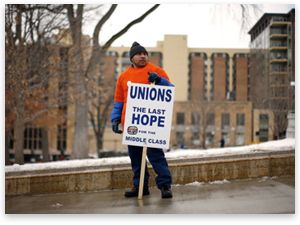Unions Might Seek 43% Tax Increase
by CalWatchdog Staff | July 10, 2011 8:49 am
 [1]JULY 10, 2011
[1]JULY 10, 2011
By JOHN SEILER
California’s government unions could seek a 43 percent tax increase on wealthy Californians. The Contra Costa Times reported[2] on the action, but missed the magnitude of the tax increase. The Times:
SACRAMENTO — Labor leaders were never overly enamored with Gov. Jerry Brown’s plan to extend taxes on purchases, income and auto fees, but were willing to go along with it to give the newly elected Democratic governor a chance to find revenues his way.
But with Brown’s plans now smoldering in ruins, his labor allies are moving to gain control of the debate over tax initiatives they hope to pursue in November 2012.
“I’m not sure which way we’ll go, but it won’t have a regressive sales or income tax on the middle class,” said Art Pulaski, secretary-treasurer for the California Labor Federation. “We’re going to want to look at a way to generate revenues that doesn’t put more burden on working folks.”
The problem is that California already has the country’s most regressive state income tax, which digs in at 9.3 percent on incomes beginning around $50,000. According to the ALEC-Laffer survey[3] released last month, California ranks 50th of the 50 states on “Personal Income Tax Progressivity.”
The Contra Costa Times continued:
“The existing tax structure basically benefits the most wealthy of us, especially corporations and the most wealthy individuals, at the expense of middle class folks,” said Dean Vogel, president of the California Teachers Association. “For the last 20 years at least, with a two-thirds vote required to pass the budget, we’ve been trading tax breaks for votes that built a structural deficit. Nobody wants to talk about it, but it’s there. It’s a heck of a way of doing business.”
Actually, the structural deficit exists because 21 years ago voters, misled into thinking they were voting for road construction, effectively repealed the Gann Limit[4], which limited increases in spending to increases in inflation plus population growth. Spending then spiraled out of control.
The Contra Costa Times again:
“We did polling, and it has huge support, so if we support an initiative for November, it would be more than 1 percent,” said Josh Pechthalt, president of the California Federation of Teachers. “I’m frankly not interested in something so minimal. I think 1 percent is much too low. It’s a misreading of where people are politically.”
Pechthalt means more than a 1 percentage point increase in taxes on the top 1 percent of income earners.
President Obama’s agreement earlier this year to extend the Bush-era taxes was a 4 percent break for the top 1 percent, Pechthalt said. [Again, he means 4 percentage point increase.]
“If we could capture that in California, that would generate $10 billion,” he said.
“Capture” Taxpayers
The Times did not note that, with the current top rate of 9.3 percent, increasing that rate 4 percentage points would mean a whopping 43 percent increase in state taxes on the wealthy. The rate would go from 9.3 percent to 13.3 percent, by far the highest in the country.
And notice how Pechthalt uses the word “capture,” which is what the state would have to do to rich people to keep them in the state if taxes increased that much. Moreover, as well as the top 9.3 percent income tax in California, there’s already an additional 1 percentage-point extra tax on incomes above $1 million to fund mental health from Proposition [5]63 [6]back in 2004.
So, the top rate potentially could be 15.3 percent. Pasting the 15.3 percent top state income tax rate top of the 35 percent top federal income-tax rate, that would total a 50.3 percent top income tax just for living in the Golden State. By contrast, leaving the state for a state without a state income tax — such as Nevada, Texas or Florida — would mean a rich person’s top income tax rate (state and federal combined) would drop from 50.3 percent to 35 percent. That would be a hefty 30 percent tax cut.
According to Ballotpedia[7], “The initiative was written by then Assemblyman Darrell Steinberg and Mental Health lobbyist Sherman Selix.” Steinberg now is the president pro-tem of the state Senate, and a major player in the state’s excessive spending and taxing mess. The CTA also was a big supporter of Prop. 63. Yet now they cry poor mouth when there’s supposedly not enough money for schools. They should have thought of that back in 2004.
 [8]Businesses Leaving
[8]Businesses Leaving
Businesses already are turning East and hitting the accelerator on their Mayflower trucks. According to Joseph Vranich[9], the Business Relocation coach:
Out-of-state economic development officials are traveling through the state to alert frustrated business owners and corporate executives to their friendlier business climate versus California’s hostility toward commercial enterprises.
* From Jan. 1 of this year through this morning, June 16, we have had 129 disinvestment events occur, an average of 5.4 per week.
* For all of last year, we saw an average of 3.9 events per week.
* Comparing this year thus far with 2009, when the total was 51 events, essentially averaging 1 per week, our rate today is more than 5 times what it was then.
Our losses are occurring at an accelerated rate. Also, no one knows the real level of activity because smaller companies are not required to file layoff notices with the state. A conservative estimate is that only 1 out of 5 company departures becomes public knowledge, which means California may suffer more than 1,000 disinvestment events this year. The capital directed to out-of-state or out-of-country, while difficult to calculate, is nonetheless in the billions of dollars.
The top five destinations are (1) Texas, (2) Arizona, (3) Colorado, (4) Nevada and Utah tied; and (5) Virginia and North Carolina tied.
Vote Not Certain
The unions may seek a “soak the rich” tax increase in November 2012, but they might not get it. An April PPIC poll[10] showed support for boosting taxes on the wealthy. But November 2012 still is 16 months away.
Meanwhile, the national economy continues to stagnate. There has been no substantial economic growth in America for four years.
On Friday, new figures[11] showed the national unemployment rate rose in June from 9.1 percent to 9.2 percent. When California’s numbers are released later this month, the unemployment rate could rise from the 11.7 percent of May.
President Obama goes into election year facing a bad economy. Republicans naturally are taking advantage of that.
In California, in the November 2010 election Democrats stemmed the rising national Republican tide, with the GOP here actually losing seats in the state Legislature. But in 2012, Democrats might not be able to repeat that feat here. Or, at least, anti-government sentiment might be able to halt a new tax increase, even one on the wealthy.
In the end, despite the unions’ dreams, the state will have to face its need for reforms on spending, especially union pay and pensions, and on taxing.
- [Image]: http://www.calwatchdog.com/wp-content/uploads/2011/07/UnionsLastHope.jpg
- Contra Costa Times reported: http://www.contracostatimes.com/top-stories/ci_18447420?nclick_check=1
- ALEC-Laffer survey: http://www.alec.org/AM/pdf/tax/11rsps/RSPS_4thEdition1.pdf
- Gann Limit: http://www.caltax.org/member/digest/July2000/jul00-9.htm
- Proposition : http://ballotpedia.org/wiki/index.php/California_Proposition_63,_Income_Tax_Increase_for_Mental_Health_Services_(2004)
- 63 : http://ballotpedia.org/wiki/index.php/California_Proposition_63,_Income_Tax_Increase_for_Mental_Health_Services_(2004)
- According to Ballotpedia: http://ballotpedia.org/wiki/index.php/California_Proposition_63,_Income_Tax_Increase_for_Mental_Health_Services_(2004)
- [Image]: http://www.calwatchdog.com/wp-content/uploads/2011/07/Mayflower-moving-truck-wikipedia.jpg
- According to Joseph Vranich: http://thebusinessrelocationcoach.blogspot.com/2011/06/calif-business-departures-increasing.html
- April PPIC poll: http://www.ppic.org/content/pubs/survey/S_411MBS.pdf
- new figures: http://apnews.myway.com/article/20110708/D9OBLU4O2.html
Source URL: https://calwatchdog.com/2011/07/10/unions-might-seek-43-tax-increase/